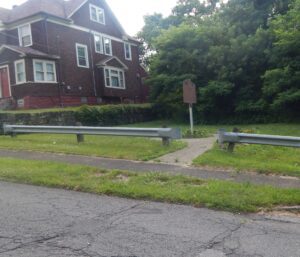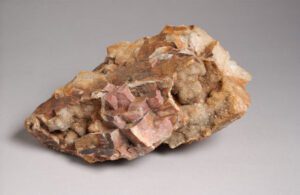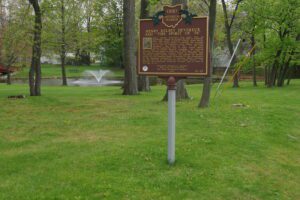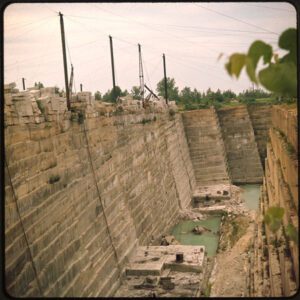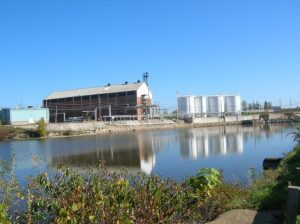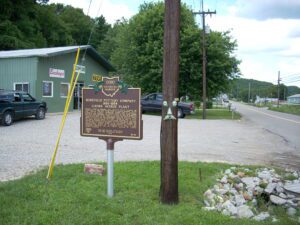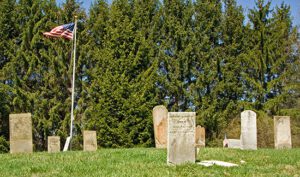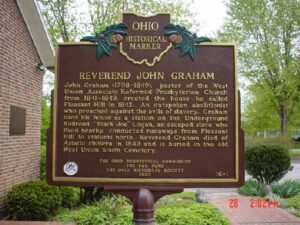, OH
Oscar D. Boggess (1832-1907) was born in Virginia, the son of a slave and her master. He and his family were granted freedom in the will of his father and master. The will was contested up to the United States Supreme Court, which upheld Boggess’ freedom. Boggess moved to Pennsylvania at age 20, and during the Civil War, joined the 43rd United States Colored Troops. He earned the Butler Medal of Honor for bravery at the Battle of the Crater near Petersburg, Virginia, in July 1864. Boggess moved to Youngstown after the war, and worked as a stonemason. He was a charter member of Tod Post 29, Grand Army of the Republic, in Youngstown, and a co-founder of the Oak Hill Avenue African Methodist Episcopal Church, the city’s first African American religious congregation. The Boggess home, formerly located near this site, hosted the church’s first meetings in 1870.
, OH
For more than 10,000 years, Flint Ridge was one of the most important flint quarries in eastern North America. The flint formed at the bottom of a shallow ocean 300 million years ago. The softer rocks surrounding the flint have washed away, leaving the hard flint exposed near the surface. Prehistoric people came here to quarry the flint, which they crafted into a variety of stone tools. Hundreds of quarry pits and workshops are scattered for miles along this ridge. The beautiful rainbow-colored flint was especially prized by the Hopewell culture that built the nearby Newark Earthworks. Artifacts crafted from Flint Ridge flint may be found throughout eastern North America. In more recent times, local industries quarried the flint for use as grindstones.
, OH
Henry Kelsey Devereux was born into an aristocratic family on October 10, 1859 in Cleveland, Ohio. Ohio artist, Archibald Willard, chose Harry, as he was fondly known, to portray the drummer boy in one of America’s most famous patriotic paintings, “The Spirit of ’76”. At the time Willard approached him to pose, young Harry was a cadet at Brooks Military Academy. He married socialite Mildred French in 1885 and in 1910 they settled in her father’s pretentious country estate in Wickliffe, Ohio (presently Telshe Yeshiva College). His passion for harness racing and for breeding horses culminated in the organization of the American Association of Trotting Horse Breeders and his position as president of the Grand Circuit. The affluent and charitable Wickliffe resident died in 1932 at the age of 72.
, OH
For more than ninety years, this area was the heart and soul of Berea’s sandstone quarries. In the early 1830s, John Baldwin discovered that the area’s sandstone deposits made superb grindstones and building stones. In the 1840s, thriving sandstone quarries developed and became Berea’s lifeblood. Searching for the “American Dream,” German, Irish, Italian, Hungarian, and Polish immigrants, among others, came here to work. The quarries eventually encompassed nearly 250 acres and consumed the fashionable houses of Berea’s “South Side” and the buildings of Baldwin University. The Cuyahoga County Court House, Ohio’s Capitol, and Canada’s parliament buildings are among many structures in North America and Europe constructed of Berea sandstone. Decreasing demand for sandstone and the Great Depression closed the last of Berea’s quarries in the mid-1930s.
, OH
Attracted by the availability of raw materials and railroad transportation, the Pittsburgh Plate Glass Company (PPG) built a plant here in 1899 to make soda ash for the company’s glassmaking operations. This plant began production in 1900 as the Columbia Chemical Company and represents the beginning of PPG’s diversified chemical manufacturing operations. During the 20th century this plant operated the world’s deepest (at 2,200 feet) limestone mine and manufactured commodity chemicals such as chlorine, caustic soda, and calcium chloride. By 2000, manufacture of specialty chemicals for the optical, pharmaceutical, printing, and rubber industries superseded mining and commodity chemical manufacturing. PPG’s reclamation of its former soda ash waste disposal sites, known as “lime lakes,” has won recognition for environmental stewardship.
, OH
Founded in 1890 in Roseville, Ohio, Roseville Pottery Company was incorporated in 1892 with George Young as general manager. At the time, Roseville produced commercial pottery such as stoneware, flowerpots, and cuspidors. The company moved to this Linden Avenue location in 1898, and began creating art pottery. By 1917, all production of pottery was moved to the Linden Avenue Plant. The Roseville Pottery Company was among the most commercially successful producers of art pottery in America until closing in 1954. During its span of sixty-four years, Roseville opened four plants and produced an enormous quantity and variety of pottery made primarily from native Ohio clay. The hallmark of Roseville Pottery is its unmistakable dynamic and artistic quality, designed for the average consumer in a modern age. Roseville’s great success can be attributed to its ability to blend commercial enterprise with the highest standards of ceramic artware production.
, OH
Smith’s Burying Ground was established in 1814 when John Smith (born 1742), Revolutionary War Veteran, died and was buried here. John Smith and four of his sons and their families made the six week, six-hundred-mile journey from New Jersey with ox teams the previous year. John Clouse (1758-1822), Dutch immigrant and Revolutionary War veteran, is also buried here. (Continued on other side)
, OH
John Graham (1798-1849), pastor of the West Union Associate Reformed Presbyterian Church from 1841-1849, erected the house he called Pleasant Hill in 1842. An outspoken abolitionist who preached against the evils of slavery, Graham used his house as a station on the Underground Railroad. “Black Joe” Logan, an escaped slave who lived nearby, conducted runaways from Pleasant Hill to stations north. Reverend Graham died of Asiatic cholera in 1849 and is buried in the old West Union South Cemetery.


